Coronavirus update 14: August 13, 2020
Dear friends,
I’ve been to Salem and back for the very short special session (we wrapped up at 11:16 PM Monday), I’ve been to the grocery store and local gardening store. My backyard tomatoes and basil are thriving. And I’m working every day on policy and fiscal issues facing the state.
We watch the news daily about COVID-19 cases and testing in Oregon, and track what’s happening in other states. School year beginning is the biggest single topic here, with concern about the students first, and then about spreading school-acquired infection back to the home and out into the broader community. Schools in other states have opened with optimism only to close within days because of infection making a quick comeback. Patience, caution, and restraint seem to be hard to achieve.
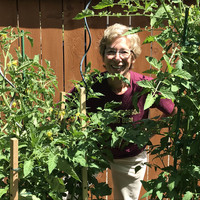
Did you see the op-ed that I published in the Register Guard? Rep. Paul Evans, from Independence (west of Salem) joined me in this letter. We’re pushing hard for action now to ensure Oregon has enough personal protective equipment (PPE) and testing supplies to weather this pandemic. And see some hopeful news from UO in the section on Testing.
I’ll give more detail about the short legislative session in my next “regular” enews, but in brief, we passed bills to balance the budget (over $1B shortfall), speed up backlogged payments to get money to unemployed people waiting for help, and in response to violence against civilians to reform law on police use of force.
When you continue reading past the section on Health and Testing you'll find sections on Help with housing, food, and unemployment assistance, Schools, Eugene pandemic response (housing, child care, recreation, more), Fire safety and "2 weeks ready" disaster preparedness.
|
Mask up, make space, and wash your hands!
Cordially,

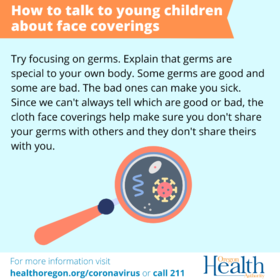
Last Week Oregon Health Authority (OHA) released an updated modeling report. Early in the pandemic, models were used to project the course of COVID-19 in Oregon when much was unknown about how the virus spreads and how prevalent the virus was in Oregon. OHA is still using it in much the same way, although we know more now about the virus, to guide safety and prevention measures. The model suggests virus transmission increased by up to 15% in May and 10% in June and July compared to low levels of transmission before May 1. The number of hospital beds and ventilators used for COVID-like cases are both remaining steady, indicating a leveling off of hospitalizations for COVID-19.
|
The age group with the highest rate of reported infection continues to be 20-29 year olds, with rates decreasing for older age groups. Hospitalizations and death rates increase as the age group increases; nearly ¾ of the 328 COVID-19 deaths are for persons 70 and older, and nearly half were among persons at least 80 years of age. OHA officials are hopeful that with increased use of safety measures like wearing masks where distance is difficult to maintain and avoiding large gatherings, rates of infection will start to decrease again and the possibility of schools to reopen will increase.
Cumulative report of cases
Here’s a snapshot of COVID-19 cases by zip code. The full table is available here. Zip codes 97389-97396 are north and west of Eugene: Tangent, Toledo, Turner, Warrenton, Willamina. 97426 is Creswell. 97439 is Florence. Note that the rate in previous tables was per 10,000.
Table columns: zip code | cumulative number of cases to date | rate per 100,000 population
Weekly Metrics for Lane County
This data comes from the OHA Weekly County Metrics. OHA explains, "For county case rates, cases are assigned to a week based on their true case date, which is the date when public health first identified them as a confirmed or presumptive COVID19 case. For percent positivity in testing, persons tested are assigned to a week based on their specimen collection date. All data are provisional and subject to change." The data here is helpful to understand the metrics used for evaluating readiness for re-opening activities and schools.
| |
Lane Co. Cases |
Cases per 100,000 |
Test positivity rate |
| 7/5/2020 |
87 |
23 |
1.9% |
| 7/12/2020 |
89 |
23 |
1.4% |
| 7/19/2020 |
53 |
14 |
1.2% |
| 7/26/2020 |
71 |
19 |
2.0% |
| 8/2/2020 |
67 |
18 |
1.7% |
Testing
Oregon’s cumulative positive test rate as of August 8 is 4.5%. This is lower than the national average of 9% and indicates a lower level of disease than the rest of the country on average. But lest we get too confident: the test positivity rate has generally been increasing since late May. This week’s test positive rate was 5.4%, and last week’s was 6.1%, one of the highest rates observed since the early pandemic. See more in Weekly Testing Summary, published August 10.
The number of tests given each week has generally remained steady, but supply chain issues continue to restrict capacity. The Oregon State Public Health Lab has been told by several major testing supply manufacturers that allocation to the State Lab and clinical labs may reduce in the coming weeks due to nationwide rising cases and increased testing demand. OHA is receiving reports the turnaround time for test results is increasing, with some results returned up to 2 weeks following collection. This is a great concern of mine, and one of the reasons I wrote the op-ed that has been published in the Register Guard and (Salem) Statesman Journal.
Hopeful news: a couple of weeks ago the University of Oregon began trials on a new COVID-19 test that instread of a nasal swab uses a saliva sample (a more traditional spit-in-a-cup approach). The test is less invasive and less expensive. With a saliva test, participants can collect the sample on their own, which reduces the need for medical staff and the PPE needed, like face masks and shields, for collecting nasal samples. If it works and gets approval from the US Food and Drug Administration, UO hopes to raise the testing capacity in Lane County and neighboring communities.
The UO is also working closely with a consortium of research institutions and companies up and down the West Coast. Read more: UO's COVID-19 monitoring and testing program, and the OPB news article
County watch list
The County Watch List is used by the state to prioritize resources and help for counties that are experiencing active outbreaks or broad community spread of COVID-19. When a county is placed on the Watch List, OHA increases monitoring and communication, and sends additional technical assistance and resources to the county, such as epidemiological support, case investigation, and contact tracing help.
So what might trigger a county to be placed on the watch list? A sporadic case rate of 50 or more per 100,000 people in the last two weeks and five sporadic cases in the last two weeks (sporadic cases are those that cannot be traced to a specific source; they indicate community spread). Once on the Watch List, the county remains on the list for at least three weeks and until the sporadic case rates drops below those markers. For some background on the reopening phases, see my newsletter from May 8.
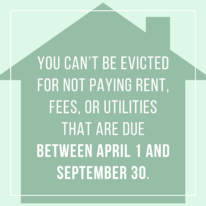
Rental housing: Oregon Law Center published a new guide to help renters and landlords understand the laws around evictions, rent repayment and more during COVID-19. Renters or landlords seeking legal help can go to OregonLawHelp.org or call Lane County Legal Aid at (541) 485-1017. Find the guide on my website here and in Spanish here.
Food: Oregon received approval from the federal Food and Nutrition Service to extend increased SNAP (food) benefits into August. SNAP households will automatically continue to receive benefits in the same way they currently do. Apply for SNAP benefits here or call the Lane County Self Sufficiency Program office at (541) 686-7878.
Pandemic Unemployment Assistance: Those waiting for PUA claims to be processed can resubmit weekly claims that have not been paid yet using the new PUA online form to receive benefits sooner. You do NOT need to resubmit the initial application. Doing so will slow the process down. It is not required to resubmit weekly claims, only strongly recommended because this form has automated features and the old application requires time-consuming, completely manual processing at the agency.
Employment Department: If you need to restart your claim or reset your PIN use the Contact Us Form through OED to get in the queue of those OED needs to help resolve an issue.
|
Schools: safe learning this fall
Governor Brown announced what it will take for schools to meet the criteria for deciding to hold in-person classes. Those metrics include a statewide rate of no more than 5% testing “positive,” and a county rate of 5% or less and fewer than 10 cases per 100,000 population. Here’s a link to the School Health and Safety Metrics including exceptions for rural districts.
OHA looked at other countries that have successfully reopened schools without a rebound in cases, and the best available data and research on how the virus spreads in children, to determine the metrics that allow safe reopening. In countries like Germany and Denmark, a low disease prevalence has shown to be the key to reopening schools safely, as well as the capacity for isolation and quarantine. An increased testing supply has not shown to be a key factor in safe reopening so long as there is enough testing supply to help control outbreaks. My concern is that the lengthy time to get results compromises the ability to contain an outbreak by quickly beginning contact tracing for positive cases.
If schools open with a high level of disease in the community, outbreaks will likely force schools to close again. A low prevalence makes it easier to isolate and quarantine positive cases. These metrics are designed to give school districts a level of certainty for planning the rest of the school year. School metrics are still evolving; ODE released revised guidance for remote and rural districts yesterday, found here. The Governor acknowledged that many school districts will have to start the year remotely given current conditions.
View the Ready Schools, Safe Learners Guidance for the upcoming school year. View County Case and Testing Rates here, which will be kept updated on OHA’s COVID-19 page.
4J starting online this year
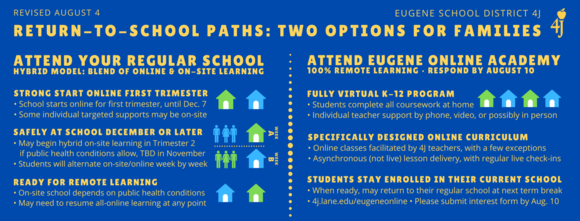
Following the Governor’s announcement, 4J announced that all students in 4J schools will learn remotely through at least the end of the first trimester in December. The school district had previously planned to begin the school year online with the goal of reintegrating students in-person mid-October.
Students may return for a hybrid of in-person and online learning for the second trimester if public health conditions allow. 4J will decide mid-November if students are returning in-person for the second trimester. If not, the District will then consider whether students can return February 1 for the second half of the trimester.
See more in 4J’s announcement and Frequently Asked Questions about 4J’s plan for the fall.
Around Eugene
I recently received an update from the city, which reports that:
- Sanitation stations are returning to downtown in high-traffic areas
- Childcare and education agencies and members of the recovery team have met to discuss options and opportunities
- The library continues to provide free summer books to youth
- Recreation is working with community partners to expand childcare capacity
- The Housing Opportunities Team is leveraging existing resources, programs, and partnerships to respond to the high and ever-changing housing needs, for example Microshelters & Mobile Outreach Teams continue to support those who are unhoused
- The recovery team is working with EWEB to discuss utility relief efforts
- Cultural Services helped turn the Cuthbert into an outdoor yoga studio, and Parks & Open spaces have adapted park rentals for fitness classes
More info: Eugene COVID-19 Web pages & Resources, Community Update e-mails (with details about topics listed above), and City Manager Letters
Library services and reading: Eugene Public Library continues to add to the services provided for library patrons. Library staff are offering free summer books for kids and teens at all three libraries. They will also be utilizing Food for Lane County summer meal sites to give books away.
Outside book returns are back at all three locations Monday through Saturday, 7 am to 5 pm. The Library is encouraging everyone to begin returning items whenever possible. Items out on loan are due mid-September, but returning books early will help the Library process requests more smoothly and get the items to others more quickly. Library patrons can continue to request items online or on the phone for curbside pickup. See more here.

All ages are welcome to sign up for the Summer Reading Program. This years theme is “Imagine your story.” Play Summer Reading book bingo, get a chance in the raffle to win gift cards to local businesses and more.
This summer, anyone in the Eugene area, including outside the City limits can access the library’s online services and catalog. Call 541-682-5450 for help accessing an online-use card.
|
Oregon Department of Forestry (ODF) maintains a Wildfire website, which includes links to a current wildfire map and a blog for wildfire news.
The State Fire Marshal (OSFM) typically uses summer as an opportunity to talk with the public on fire safety at community gatherings. Without the ability to meet in person, Office of Emergency Management (OEM) offers these tips: Know your local fire restrictions and always pack water and a shovel. If you make a campfire, be sure it’s dead out before leaving, even if just for a hike. To learn about restrictions and wildfire activities at home, at work and when you are out and about, visit www.KeepOregonGreen.org/prevent-wildfires. Additional information: ODF wildfire blog; Oregon's smoke blog; ODF Significant Fire Potential Map
COVID-19 continues to impact all fire agencies, from PPE supplies to managing safety protocols that minimize virus transmission among their workers. The Governor’s Council on Wildfire Response described this year’s fire conditions as out of balance as we live with a “new wildfire reality.” Around 90% of the state is currently in a drought (see my previous enews). Warmer and drier-than-normal conditions are expected to last through at least the end of the month and nearly all of the state is under extreme wildfire conditions. “Escaped debris burns” are the largest cause of wildfires statewide. |
|
 |
Be prepared for two weeks during a disaster
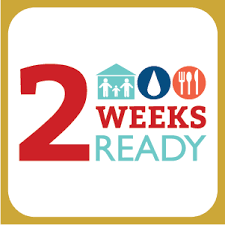
OEM’s "2 Weeks Ready" initiative encourages Oregonians to prepare for natural disasters and emergencies, such as the Cascadia earthquake. Having a minimum of two weeks of supplies on hand allows your household to be self-sufficient and lessens the burden on emergency supplies and responders. Being prepared also mitigates the effects of risks such as heat waves, power outages, and even COVID-19 as people may need to isolate at home for as long as 14 days.
|
This short video shows the basics of a 2 Weeks Ready kit, including face coverings and hand sanitizer. Everyone’s kit will be customized differently to fit the needs of their household. Go to OEM for more information.
Building a Safe and Strong Oregon: reopening plan, County status and Statewide guidance
Lane County Public Health: Local data, Blueprint for reopening and Community resources
Oregon Health Authority (with a link to subscribe to their news service)
Oregon Health Plan (open enrollment)
University of Oregon webpage on UO's COVID-19 response
Oregon Office of Emergency Management OEM COVID-19 response
Employment Department: for business: Work Share
Unemployment Insurance Online Claims and new Pandemic Unemployment Assistance
Bureau of Labor and Industries Coronavirus and Workplace Laws
Department of Human Services.
Department of Education
Oregon Food Bank's Food Finder
Oregon Law Center: Information on housing & employment protections, domestic violence aid, emergency public assistance and more
Team Nathanson: Lindsay, James, and me

|